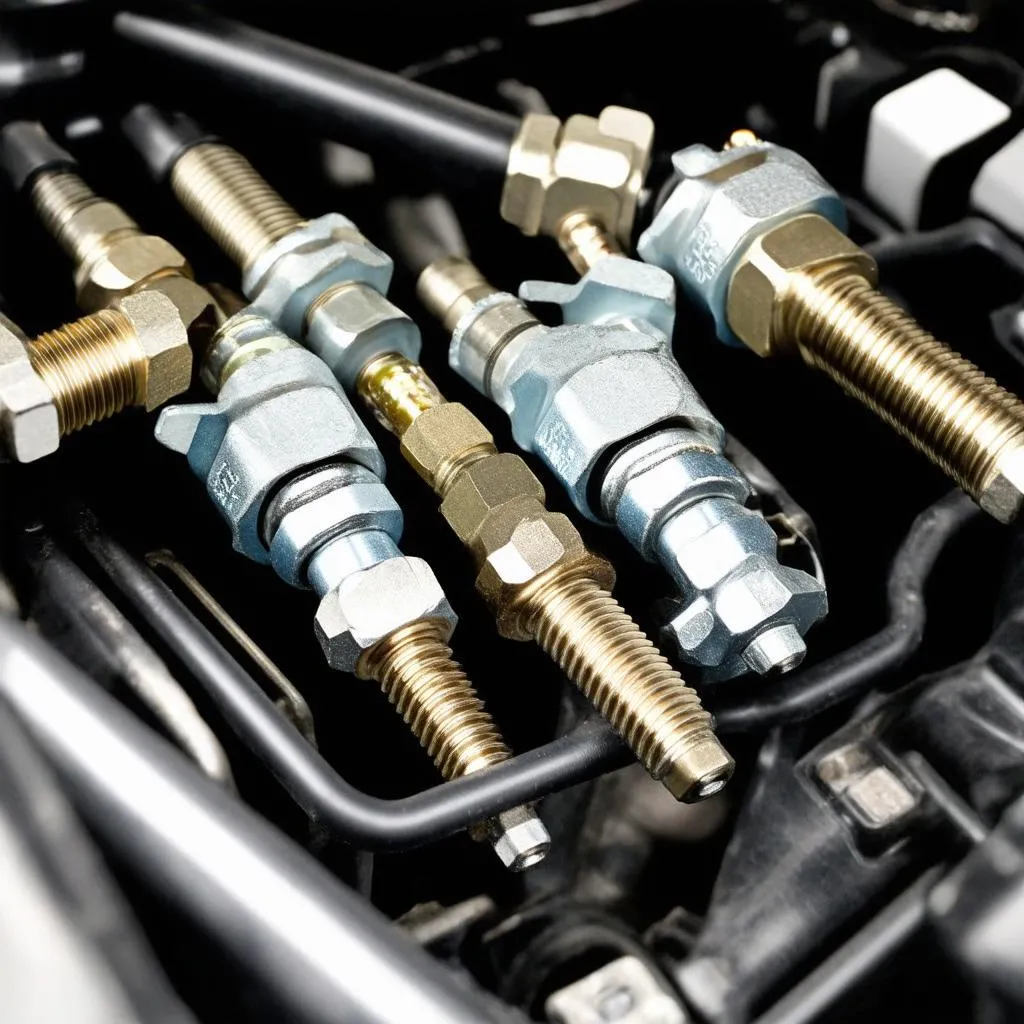Have you ever been driving down the road when your Ford engine starts to sputter and misfire? It’s a scary experience, and it can leave you wondering what’s wrong. If you’ve checked your engine light and found the code “P0300”, you’ve come to the right place. In this article, we’ll explore everything you need to know about the “P0300” code and how to get your Ford back on the road.
What Does Ford OBD II Code P0300 Mean?
The “P0300” code stands for “Random/Multiple Cylinder Misfire Detected.” This means that your engine’s computer has detected a misfire in one or more cylinders. But why is this happening?
Let’s take a step back and understand what a misfire actually is. Imagine each cylinder in your engine as a tiny explosion. Each time a spark plug ignites the air-fuel mixture, a tiny explosion occurs, pushing the piston down and generating power. A misfire happens when this explosion doesn’t occur properly, either because the fuel isn’t burning completely or because the spark plug isn’t firing.
This code is a “general” misfire code meaning that the engine’s computer can’t pinpoint exactly which cylinder is misfiring. This can make troubleshooting a bit more difficult, but we’ll delve deeper into that shortly.
Why Is My Ford Throwing a P0300 Code?
Now, why is your Ford throwing a “P0300” code? Let’s explore some common culprits:
1. Spark Plugs & Ignition System:
Imagine your spark plugs as the tiny detonators in your engine. If they’re worn out, damaged, or fouled, they won’t ignite the fuel properly, resulting in a misfire. This could be due to:
- Worn Out Spark Plugs: Just like any other part, spark plugs have a lifespan. Even if you’re not driving a 1994 Honda Accord, your spark plugs eventually need replacing.
- Damaged Spark Plug Wires: The wires that carry the electrical current to the spark plugs can also become damaged, cracked, or corroded, preventing a good spark from reaching the spark plug.
- Faulty Ignition Coils: These are responsible for generating the high voltage needed to ignite the spark plugs. If they’re failing, the spark will be weak, leading to a misfire.
2. Fuel System Issues:
The fuel your engine uses plays a crucial role in the combustion process. Here are some fuel-related problems that can cause a “P0300” code:
- Clogged Fuel Injectors: These tiny devices deliver precise amounts of fuel to each cylinder. Over time, they can become clogged with dirt and debris, leading to an improper fuel-air mixture and misfires.
- Fuel Pressure Regulator Problems: This component regulates the amount of fuel pressure in the system. If it’s not working correctly, it can lead to too much or too little fuel being delivered to the engine, causing misfires.
- Low Fuel Pressure: A leak in the fuel lines or a faulty fuel pump can cause low fuel pressure, leading to an insufficient amount of fuel reaching the cylinders and misfires.
3. Engine Management System Malfunctions:
The engine’s computer, also known as the Engine Control Module (ECM), is responsible for controlling various aspects of your engine’s operation, including fuel delivery, ignition timing, and emissions. A malfunction in this system can cause a “P0300” code:
- Faulty Oxygen Sensors: These sensors measure the amount of oxygen in the exhaust gases, providing feedback to the ECM. If they’re not working properly, it can disrupt the air-fuel mixture, leading to misfires.
- Vacuum Leaks: A leak in the vacuum system can disrupt the airflow to the engine, leading to incorrect fuel delivery and misfires.
- Faulty Mass Airflow Sensor (MAF): This sensor measures the amount of air entering the engine. A faulty MAF sensor can provide incorrect information to the ECM, causing it to adjust fuel delivery incorrectly, resulting in misfires.
4. Other Potential Causes:
- Compression Issues: If the engine’s compression is low, it can make it difficult to ignite the fuel properly, leading to misfires.
- Timing Belt Issues: A stretched or broken timing belt can affect the timing of the engine’s valves, leading to misfires.
- Catalytic Converter Problems: A clogged catalytic converter can restrict exhaust flow, leading to a buildup of pressure in the engine and misfires.
- Faulty Engine Sensors: Various other sensors in the engine, such as the crankshaft position sensor, camshaft position sensor, or knock sensor, can malfunction and cause misfires.
How to Diagnose a P0300 Code:
The “P0300” code is a starting point. Now that you understand the possible causes, you can begin diagnosing the problem. Here’s a breakdown:
-
Inspect Spark Plugs and Wires: Start by visually inspecting the spark plugs and wires. Are they worn out, cracked, or corroded? If so, they need to be replaced.
-
Test the Ignition Coils: You can use a multimeter to test the ignition coils for resistance. If they’re not within the specified range, they need to be replaced.
-
Check Fuel Pressure: Use a fuel pressure gauge to measure the fuel pressure in the system. If it’s too low or too high, it could indicate a problem with the fuel pump, regulator, or fuel lines.
-
Scan for Additional Codes: Use an OBD II scanner to scan for any other codes that might provide more specific information about the misfire.
-
Use a Diagnostic Tool: If you’re not comfortable troubleshooting yourself, a diagnostic tool like a Dealer Scanner For European Cars can help you pinpoint the issue.
-
Consult a Professional: If you’re still unable to diagnose the problem, it’s best to take your Ford to a qualified mechanic.
How to Fix the P0300 Code:
Once you’ve identified the cause of the “P0300” code, you can proceed with the necessary repairs.
-
Replace Worn Spark Plugs: Replace worn out spark plugs with the correct type for your Ford model.
-
Repair or Replace Damaged Wires: Repair or replace any damaged spark plug wires.
-
Replace Faulty Ignition Coils: Replace any faulty ignition coils.
-
Clean or Replace Fuel Injectors: Clean the fuel injectors using a fuel injector cleaner or replace them if they’re heavily clogged.
-
Check Fuel Pressure and Address Leaks: Inspect the fuel pressure and repair any leaks in the fuel lines or fuel pump.
-
Inspect and Replace Sensors: Inspect the oxygen sensors, mass airflow sensor, and other engine sensors for damage or wear. Replace them if necessary.
-
Address Vacuum Leaks: Inspect the vacuum system for leaks and repair them as needed.
-
Address Compression Issues: If compression issues are found, they need to be addressed by a professional mechanic.
-
Replace Timing Belt: Replace the timing belt if it’s stretched or broken.
-
Replace Catalytic Converter: Replace the catalytic converter if it’s clogged.
Frequently Asked Questions:
1. Will a P0300 Code Cause My Ford to Stall?
While a misfire can cause your engine to run rough or sputter, it might not necessarily cause it to stall completely. However, if the misfire is severe enough, it can lead to stalling, especially at low speeds or idle.
2. Can I Keep Driving With a P0300 Code?
It’s generally not recommended to continue driving with a “P0300” code. A misfire can put extra stress on your engine, potentially leading to further damage. If the misfire is minor, you might be able to drive short distances, but it’s best to get the problem diagnosed and repaired as soon as possible.
3. Can I Reset the P0300 Code Myself?
You can clear the “P0300” code using an OBD II scanner, but that doesn’t mean the problem is solved. The code will reappear if the underlying issue isn’t addressed.
4. How Do I Know Which Cylinder Is Misfiring?
The “P0300” code is a general misfire code, but sometimes more specific codes might appear. For example, a “P0301” code indicates a misfire in cylinder 1. Using a diagnostic tool can help you pinpoint the specific cylinder.
5. What Can I Do to Prevent a P0300 Code From Occurring Again?
Preventative maintenance can help.
-
Regular Spark Plug Replacement: Follow your Ford’s recommended maintenance schedule for spark plug replacement.
-
Fuel System Cleaning: Use fuel injector cleaner regularly to prevent clogging.
-
Preventative Maintenance: Regularly check for vacuum leaks and maintain your engine’s timing belt.
Conclusion:
The “P0300” code can be a frustrating experience, but it’s important to remember that it’s a signal that something needs attention. By understanding the potential causes and how to diagnose the problem, you can get your Ford back on the road and running smoothly. Remember, a dealer scanner can be invaluable in diagnosing complex issues. If you’re not comfortable troubleshooting yourself, don’t hesitate to consult a professional mechanic.
We encourage you to leave a comment below if you have any questions. Let us know your experience with “P0300” codes in Ford vehicles. And be sure to check out our other articles for more information about car maintenance and repair.
 Ford Obd Ii P0300 code" width="1024" height="1024">Ford OBD II P0300 code
Ford Obd Ii P0300 code" width="1024" height="1024">Ford OBD II P0300 code
 Spark plugs
Spark plugs
 Fuel injector
Fuel injector
Need help with your Ford? Contact us via WhatsApp: +84767531508 for expert assistance with diagnostics tools and 24/7 support from our automotive experts.